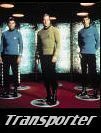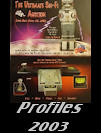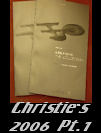Paul Allen, who co-founded MicroSoft with Bill Gates, is a well known collector of Star Trek and science fiction memorabilia. His private asset management company, of which he is the founder and chairman, is called Vulcan, Inc. Many of Mr. Allen's most celebrated TOS collectibles, including the original Captain's Chair used on the Bridge set of the Enterprise for all three seasons of production, are on display at the Science Fiction Museum and Hall of Fame in Seattle, Washington. Some pictures of The Original Series items on display are presented below.
Monday, April 28, 2008
Sunday, April 27, 2008
Rare 1966 Video Interviews with William Shatner and Leonard Nimoy On The Set
These interviews were taped just prior to Star Trek's NBC premiere in September 1966 on the set of the episode "What Are Little Girls Made Of?" (The 9th episode produced and the 7th episode to be broadcast, which had an Original Airdate of October 20, 1966.) The interviewer is Harry Martin from KCRA Channel 3 in Sacramento, CA.
While the video quality is not strong; these clips are historic moments with the 2 main stars of The Original Series discussing a show that has yet to be seen by the public.
Saturday, April 26, 2008
The Star Trek Original Series Production Crew
These are the outstanding talents responsible for the creation and production of Star Trek behind-the-scenes:
Gene Roddenberry (August 19, 1921 - October 24, 1991) – the Creator of Star Trek; also a screenwriter and Executive Producer
Herbert F. Solow – Vice President of Production for Desilu Studios; he oversaw the development, sales and production of Star Trek
Robert H. Justman (July 13, 1926 - May 28, 2008) – Assistant Director then Associate Producer and Co-Producer of Star Trek
John M. Dwyer – Emmy Award-winning and Academy Award nominated Set Decorator of Star Trek
Walter “Matt” Jefferies (August 12, 1921 – July 21, 2003) – Art Director and Production Designer of Star Trek; best known as the creator of the U.S.S. Enterprise starship design, he also designed the bridge layout for the Enterprise (which influenced the design of the U.S. Navy master communications center at NAS San Diego), the Klingon battle cruiser, and the phaser
William “Bill” Ware Theiss (November 20, 1930 – December 15, 1992) – Costume Designer of Star Trek, creator of the Starfleet uniforms, formal dress tunics, Vina’s Orion slave girl costume, Lt. Palamas’ Greek robe and every other costume that appeared in the original 79 episodes of TOS. Remembered for his daring and revealing designs developed for female guest stars and his unconventional use of materials.
Wah Ming Chang (August 2, 1917 – December 22, 2003) – Artist, Sculptur and Master of Special Effect – designed and manufactured the TOS communicator and TOS tricorder hand props, the Cage laser pistol, the Balok puppet from “The Corbomite Maneuver”, the Romulan Bird-of-Prey starship, the Gorn costume from “Arena”, the Romulan helmets and ears from “Balance of Terror” and the M-113 creature or Salt Vampire from “The Man Trap”
Irving A. Feinberg (February 27, 1908 - August 20, 1991) – Property Master of Star Trek; the cast and crew of TOS informally referred to all of the props on the show as “Feinbergers”
Fred B. Phillips (April 26, 1908 – March 21, 1993) – award-winning Make-up Artist, created and applied the Spock ears to Leonard Nimoy on a daily basis during TOS production
James “Jim” Rugg (January 29, 1919 – February 13, 2004) – Supervisor of Special Effects; won an Emmy Award for mechanical special effects for first season of TOS
Alexander Courage (December 10, 1919 - May 15, 2008) – Music Composer, orchestrator & arranger– developed the “main theme” for Star Trek, and also composed full-length scores for at least four episodes (The Cage, Where No Man Has Gone Before, The Man Trap, The Naked Time). His cues were then tracked in countless other episodes.
Jerry Finnerman (born December 17, 1931)– Cinematographer, Director Photography
Douglas S. Cramer – Executive Producer
Gene L. Coon - Producer
John Meredyth Lucas - Producer
Bernard A. Widin – Producer
John D. F. Black – Associate Producer & Story Editor
Gregg Peters – Associate Producer
Margaret Makau – Wardrobe Mistress
First Assistant Directors: Elliot Schick, Rusty Meek, Gil Kissel, Michael S. Glick, GeneDe Ruelle, Claude Binyon, Jr., Phil Rawlins
Casting: Joseph D'Agosta, William J. Kenney
Music Supervisor: Wilbur Hatch
Music Coordinator: Julian Davidson
Music Editors: Robert H. Raff, Richard Lapham, Jim Henrikson, James Ballas
Music: Joseph Mullendore, Samuel Matlovsky, Sol Kaplan, George Duning, Gerald Fried, Jerry Fielding, Fred Steiner, Ivan Ditmars
Hair Stylists: Virginia Darcy, Pat Westmore
Make-up: John Chambers
Grip: George Rader
Set Decoration: Carl Biddiscombe, Marvin March, Joseph J. Stone
Property Masters: Adam John Backauskas
Gaffer: George H. Merhoff
Assistant to the Producer: Edward K. Milkis
Key Costumer: Ken Harvey
Executive Story Editor & Script Consultant: D. C. Fontana
Script Consultant: Steven W. Carabatsos
Story Consultant: Arthur H. Singer
Film Editors: Fabien D. Tordjmann, Bruce Schoengarth, Donald R. Rode, Frank P. Keller, John Hanley, Bill Brame, Robert L. Swanson
Art Director: Rolland M. Brooks
Art Department: Jim Danforth
Director of Photography: Al Francis
Sound Editors: Joseph G. Sorokin, Jim Bullock
Sound Mixers: Cam McCulloch, Jack F. Lilly, Doug Grindstaff, Gordon L. Day, Carl Daniels
Special Effects: Albert Whitlock, Roger Dorney, Joseph Westheimer, Linwood G. Dunn, Darrell Anderson
Graphics: Michael Minor
Sound Recordist: Elden Ruberg
Post Production: Bill Heath
Research: Kellam De Forest
Other: Thomas Kellogg
Stunts: Richard Antoni, Bobby Bass, Paul Baxley, Bob Bralver, Frank Da Vinci, Al Wyatt, Jerry Summers, Tom Steele, Paul Stader, Roy N. Sickner, Carl Saxe, Bill Catching, Bobby Clark, David Sharpe, Bob Orrison, Bob Miles, Troy Melton, Bob Lyon, Carey Loftin, Jim Jones, Dick Dial, Vince Deadrick, Sr., Chuck Clow, Jesse Wayne, William Blackburn, Jay Jones, Donna Garrett, Gary Combs, Frank Babich, Victor Toyota, Chuck O'Brien, Julie Ann Johnson, Bob Herron, Dick Geary, Bennie E. Dobbins, Denver Mattson, Hal Needham, Chuck Couch, Allen Pinson, David Perna, Regina Parton, Max Kleven, Loren Janes, Alan Gibbs, Ralph Garrett, Louie Elias, Gary Downey, Dick Crockett, Phil Adams
Many thanks to fellow TOS fan John Garrett for technical support in the formulation of the above lists, especially in the Research and various Music related categories.
The Production Credits as shown per season are displayed below:
Friday, April 25, 2008
Some Photos of a Dwyer Collection Stunt Hand Phaser (Type I)
This was one of the hand phasers sold in the 2001 Profiles In History Star Trek Auction, featuring the collection of Art Director Matt Jefferies. This Type I phaser was accompanied by a certificate from TOS Set Decorator John Dwyer.
Tuesday, April 22, 2008
Design Features of Screen Used TOS Tricorders
At the onset of this article; it should be noted that it is not my intent to represent the following compilation as a complete or all-inclusive listing. It is merely a fairly comprehensive collection of design characteristics taken from many of my best reference photos. In creating this work, I have restricted the contributing photos utilized to TOS episode screenshots, photos of high-profile auction items with impeccable provenance (that come directly from a Dwyer Profiles In History auction) or published Star Trek doctrine (such as Wah Chang or The Art of Star Trek accredited images). Much more so than with the phaser and communicator props; I was struck by the diversity of alternate materials, differing dimensions, color patterns and alternate geometries found on the authentic Tricorder props. The fabrication of a Tricorder for TOS did not seem to be an exercise in part standardization; as these Original Series props were known to be created by Wah Ming Chang as well as the Desilu internal prop shop; and were known to come in three different styles: vacuuformed plastic, fiberglass and leatherette covered assemblies. (There was a fourth “ultimate” stunt version seen in “Miri” as well as “Shore Leave” … composed of cardboard!)
As my own collection of reference images grows, I shall add new variants to this post.
Sunday, April 20, 2008
TOS Tricorder Measurements Study
Below is a high resolution version of the famous Tricorder image seen in the 1968 book “The Making of Star Trek” by Stephen Whitfield and Gene Roddenberry; followed by some rare additional photos of this same piece and a screenshot testifying to its use in the highly acclaimed TOS episode “The City on the Edge of Forever”.
Next, a modern photo of the TOS Tricorder seen in “Day of the Dove”; and a screenshot from that episode.
When the modern day image of the Day of the Dove (DD) Tricorder is rotated; it appears in a very similar orientation spatially as The Making of Star Trek (TMOST) Tricorder; which facilitates measurement analysis. In the following composite photo, both pieces are presented in the same scale – so that a single common reference distance known to be identical on the 2 props is set to be equal. CAD software is then used to generate measures on a series of other comparable geometries to provide insight into the normal size variations to be expected when encountering authentic TOS Tricorder hand props.
Note: The units listed on the photo below are not precise reflections of the actual prop dimensions in either British or Metric units; they were derived by taking an exact measure in Inches and applying a scaling factor – however, the distances listed are sufficiently close to Inches that a discussion of variation in the next paragraph which makes reference to Inches is still accurate.
It can be seen that several measured distances, such as the thickness of the aluminum plates used to construct the side frames and large cross member on the two pieces; as well as the diameters of the indicator light bezels and control knobs – are identical on both Tricorders. However, significant variation is observed in the cutouts for the microphone and viewscreen on the main control panel faceplate; and the height and width measurements of the main bodies for these two screen-used pieces are seen to vary by as much as a quarter of an inch. Unlike communicators, whose main body consisted of a single vacuuformed shell; Tricorders were much more complex assemblies subject to the cumulative length differences in hand-cut cross members, screwed in shell attachments, and differently aligned vertically mounted hood assemblies, etc. Even layers of leatherette covering present on some pieces but excluded on others would generate a measurable difference in component thickness.
The following image shows two other authentic TOS Tricorders photographed in the home of Star Trek Set Decorator John Dwyer; which are now part of the Allen and Gurian collections. In the composite photo afterwards, the Gurian Tricorder has been positioned to replicate the orientation of the Allen piece shown above it to facilitate another measurement study. (Note: My dog insisted in being a part of the second photo.)
Interestingly, the overall measured height and width differences between these two pieces are only approximately one-tenth of an inch or less apart; which is significantly less than that observed between the TMOST and Day of the Dove pieces.
Saturday, April 12, 2008
Special PhotoStudy: Admiral Kirk Starfleet Class A Uniform from Star Trek: The Motion Picture
Worn by William Shatner upon reprising his role as James T. Kirk in the very first Star Trek feature film that was produced; filmed less than 10 years after the end of production of The Original Series, this costume is part of the Gurian Collection and was obtained with impeccable provenance directly from the Paramount/CBS representative for Star Trek memorabilia sales – ItsAWrap LLC. As the first scene of Star Trek: TMP was filmed on the afternoon of August 7, 1978; this costume is 30 years old in 2008 and is, I believe, the only Kirk Class A Uniform ever offered at auction. (The famous Christies 40th Anniversary Star Trek auction featured a Spock Class A, a McCoy Class A and a Scotty Class A, as well as a Kirk Class D jumpsuit from TMP; but not a Kirk Class A.) It contains a Western Costume Company sewn-in label which states William Shatner’s name, Chest & Sleeve measurements and denotes the Costume as Number 1 (with a roman numeral nomenclature) – which I believe identifies it as the main filming version. The interior of the uniform top exhibits frayed lining; there are minor signs of distress or fraying on the outside arms (along seam lines); and the pant cuffs are frayed – however, the overall garment displays well and is an excellent color match to some screenshots presented below. The wrinkling of fabric along the neckline in particular matches a closeup view of Shatner in-costume in the Enterprise 1701 Captain’s Chair. The pants contain a sewn-in Paramount label; however, there is no writing legible on the label. The tunic and pants were accompanied by an unattached plastic biomonitor, that is loosely held in place at present by several strands of thread and may be easily removed. Perhaps the most desirable screen worn Shatner item next to an authentic TOS Kirk tunic; and perhaps of greater rarity since multiple TOS Shatner tunics have sold at auction over the years. Certainly a unique and historic Star Trek collectible.



















































































































































